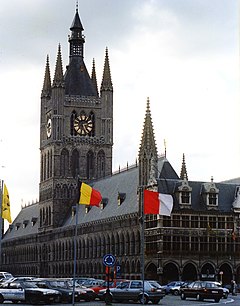Ypres Cloth Hall
| Ypres Cloth Hall | |
|---|---|
| Lakenhal or Lakenhalle | |

Modern-day view of the reconstructed Cloth Hall
|
|
|
Location of Ypres Cloth Hall
|
|
| General information | |
| Architectural style | Gothic |
| Location | West Flanders, |
| Country | Belgium |
| Coordinates | 50°51′04″N 2°53′09″E / 50.8512°N 2.8858°E |
| Construction started | 13th c |
| Estimated completion | 1304 |
| Renovated | 1933–1967 |
| Height | 70 m (230 ft) |
| Design and construction | |
| Architect | J. Coomans and P. A. Pauwels |
| Other information | |
| Parking | On site |
| Website | |
| Ypres: The Cloth Hall | |
The Cloth Hall (Dutch: Lakenhal or Lakenhalle) is a large cloth hall, a medieval commercial building, in Ypres, Belgium. It was one of the largest commercial buildings of the Middle Ages, when it served as the main market and warehouse for the Flemish city's prosperous cloth industry. The original structure, erected mainly in the 13th century and completed 1304, lay in ruins after artillery fire devastated Ypres in World War I. Between 1933 and 1967, the hall was meticulously reconstructed to its prewar condition, under the guidance of architects J. Coomans and P. A. Pauwels. At 125 metres (410 ft) in breadth, with a 70 metres (230 ft)-high belfry tower, the Cloth Hall recalls the importance and wealth of the medieval trade city. The building now houses the In Flanders Fields Museum.
In a row spanning the front of the edifice are tall pointed arches that alternately enclose windows and blind niches. Before the Great War, the niches framed life-size statues of historical personages, counts and countesses of Flanders. The niches on the side wings are now mostly vacant, but those in the centre contain statues of Count Baldwin IX of Flanders and Mary of Champagne, legendary founders of the building; and King Albert I and Queen Elisabeth, under whose reign the reconstruction began. Situated between these two couples, directly above the central archway entrance or Donkerpoort, is a statue of Our Lady of Thuyne, the patron of Ypres.
The belfry, capped with four turrets and a spire, houses a carillon with 49 bells. From a pole atop the spire a gilded dragon overlooks the city. The tower offers an expansive view of the surroundings, and was used as a watchtower in centuries past. It has also accommodated the town archives, a treasury, an armory and a prison. In less enlightened times, cats were thrown off the belfry for reasons that are not clearly understood. One theory is that cats were in some way associated with black magic. A different theory is that cats were held to protect the cloth against mice, but the annual excess of kittens had to be dealt with in some way. Today, a jester commemorates this act by tossing stuffed toy felines from the tower during the triennial Cat Parade.
...
Wikipedia

